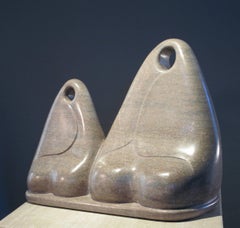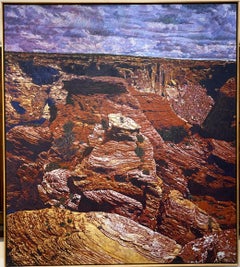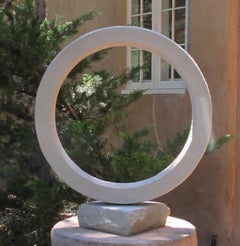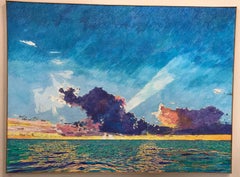Glenn Green Galleries Art
to
3
99
44
68
38
113
Overall Width
to
Overall Height
to
167
195
1
5
7
38
40
74
331
10
80
75
14
69
34
30
24
23
20
20
18
13
12
11
9
9
8
6
6
6
5
5
5
141
79
69
43
43
64
30
29
28
27
36
353
Seeing the Sunset, Allan Houser pink Tennessee marble, abstract couple, Apache
By Allan Houser
Located in Santa Fe, NM
Seeing the Sunset, Allan Houser pink Tennessee marble, abstract couple, Apache
Seeing the Sunset, pink Tennessee marble, abstract couple, Apache Alla...
Category
1990s Contemporary Figurative Sculptures
Materials
Marble
Salmon River, John Hogan contemporary large painting blue orange black
By John Hogan (American)
Located in Santa Fe, NM
Salmon River, contemporary mixed media large-scale painting blue orange black horizontal
John Hogan A graduate of Northeast Louisiana State Univ...
Category
2010s Contemporary Landscape Paintings
Materials
Mixed Media
Canyon and Clouds, desert landscape painting, red, purple, brown John Hogan
By John Hogan (American)
Located in Santa Fe, NM
Canyon and Clouds, desert landscape painting, red, purple, brown John Hogan
Southwest desert landscape painting with rich colors and texture.
John Hogan
A graduate of Northeast Louisiana State University with a Bachelors degree and New Mexico Highlands University with a Masters in Art Hogan studied with Edward Schutz and Elmer Schooley...
Category
Early 2000s Contemporary Landscape Paintings
Materials
Oil Crayon, Acrylic
Sunlight Cottonwood, desert landscape painting, canvas, yellow, blue, green
By John Hogan (American)
Located in Santa Fe, NM
mixed media painting by master printmaker and painter John Hogan.
John Hogan
A graduate of Northeast Louisiana State University with a Bachelors degree and New Mexico Highlands University with a Masters in Art Hogan studied with Edward Schutz and Elmer Schooley...
Category
Early 2000s Contemporary Landscape Paintings
Materials
Acrylic
Subject Object, John Reeves, limestone sculpture, circular, hand carved, garden
By John Reeves
Located in Santa Fe, NM
limestone sculpture
steel pin mounts to square base so it will turn
Category
2010s Contemporary Abstract Sculptures
Materials
Limestone
Sunset Sea Clouds, Key Largo, blue, pink, green, textured painting, light, large
By John Hogan (b.1800)
Located in Santa Fe, NM
Sunset Sea Clouds, Key Largo, blue, pink, green, textured painting, light, large-scale seascape painting
Category
2010s Contemporary Landscape Paintings
Materials
Canvas, Crayon, Acrylic
Two Minds Meeting sculpture by Melanie Yazzie, blue aluminum people animals
By Melanie Yazzie
Located in Santa Fe, NM
Two Minds Meeting sculpture by Melanie Yazzie, blue aluminum people animals edition of 24
Please allow 6 weeks for completion by the foundry.
Contac...
Category
Early 2000s Contemporary Figurative Sculptures
Materials
Metal
Untitled Figure with X on Chest by Charlie Willeto, Navajo Folk Art, wood, paint
By Charlie Willeto
Located in Santa Fe, NM
Untitled Figure with X on Chest by Charlie Willeto, Navajo Folk Art, wood, paint
Vintage
Category
1960s Folk Art Figurative Sculptures
Materials
Wood, Paint
Green Free Range Critter, soft sculpture, by Kerry Green, Oppenheimer, felt, fun
By Kerry Green
Located in Santa Fe, NM
Since childhood, Kerry Green has always been creative; painting, drawing, sculpting, and sewing. Her family provided her with materials and encouraged her efforts. She literally grew...
Category
2010s Contemporary Figurative Sculptures
Materials
Felt, Plastic
Different Directions by Melanie Yazzie, monotype, fish, bird, blue, red, gold
By Melanie Yazzie
Located in Santa Fe, NM
Different Directions by Melanie Yazzie, monotype, fish, bird, blue,red,gold
unframed, unique monotype
As a printmaker, painter, and sculptor, my work draws upon my rich Diné (Navajo...
Category
2010s Contemporary Animal Prints
Materials
Monotype
Basket, Parrot, Toucan designs Panama Rainforest Wounaan Tribe
Located in Santa Fe, NM
Basket, Parrot, Toucan designs Panama Rainforest Wounaan Tribe
handwoven with palm fibers and vegetal dyes
The baskets are made by the Wounaan and Embera Indians from the Darien R...
Category
1990s Tribal More Art
Materials
Organic Material
The Reader, Rodger Jacobsen gold bronze sculpture, reading book, glasses
By Rodger Jacobsen
Located in Santa Fe, NM
The Reader (small),Rodger Jacobsen gold bronze sculpture, reading book, glasses
The Reader (small), gold bronze sculpture, reading book, glass...
Category
2010s Contemporary Figurative Sculptures
Materials
Bronze
Aspen Trail- Fall, color etching, John Hogan, yellows, gold, landscape forest
By John Hogan (American)
Located in Santa Fe, NM
Aspen Trail- Fall, color etching,John Hogan, yellows, gold, landscape forest
hand pulled limited edition color etching
22 x 30 paper size
18 x 24 image size
unframed
edition signed ...
Category
1990s Contemporary Landscape Prints
Materials
Etching
Cavallo, by Ferruccio Ferrazzi, Religious, Painting, Horse, Vatican, Brown, Tan
By Ferruccio Ferrazzi
Located in Santa Fe, NM
Cavallo, by Ferruccio Ferrazzi, Religious, Painting,Horse, Vatican, Brown,Tan
“Cavallo” by Ferruccio Ferrazzi is a work lost during World War II and restored by the Mosaic School of Art at Vacan City. Circa 1940s.
Ferruccio Ferrazzi (15 March 1891 – 8 December 1978 in Rome) was an Italian painter and sculptor as well as a professor at Accademia di Belle Arti of Rome.)
Born in Rome, Ferrazzi was the eldest son of the sculptor Stanislao Ferrazzi. In 1904, he was trained in the studio of Francesco Bergamini, a former pupil of Michele Cammarano. The following year he attended the Scuola Libera del Nudo and at the Accademia di Francia. He first exhibited at the 1907 Exhibition (LXXVII Esposizione Internazionale di Belle Arti) in Rome. In 1910, he won a scholarship to the Instituto Catel which allowed him to take up art as a career.
In 1913, he exhibited Genetrix at the First Roman Secession Exhibition (Prima Esposizione internazionale d'arte della Secessione Romana). In December, he was granted the national art pension which gave him financial security and allowed him to set up a studio in Via Ripetta. A visit to the Louvre in Paris revealed his interest in Georges Seurat whose style was similar to his own.
In 1926, he became a professor at the Accademia di San Luca. The same year he was the first Italian to win the Carnegie Prize. In the spring of 1933, he was elected to the Italian Academy. After the war, he created mainly religious works, both paintings and sculptures. In the 1950s, he spent most of his time at the Casa di Santo Stefano in Monte Argentario where he created his ambient sculpture Il Teatro...
Category
1940s Contemporary Animal Paintings
Materials
Canvas, Oil
Chaco Visit, by Melanie Yazzie, Mixed Media, Painting, Yellow, Blue, Black, Pink
By Melanie Yazzie
Located in Santa Fe, NM
Chaco Visit, by Melanie Yazzie, Mixed Media, Painting,Yellow, Blue, Black, Pink
Melanie Yazzie works in a wide range of media that include printmaking, painting, sculpting, and cera...
Category
2010s Contemporary Abstract Paintings
Materials
Canvas, Charcoal, Acrylic
Storage & Saving, painting, by Melanie Yazzie, abstract, Navajo, Blue, yellow
By Melanie Yazzie
Located in Santa Fe, NM
Storage & Saving, painting, by Melanie Yazzie, abstract, Navajo, Blue, yellow
Category
2010s Contemporary Abstract Paintings
Materials
Canvas, Acrylic
Corn Kachina, by Riley Sunrise, Quoyavema, Hopi, Kachina, Dancer, painting
Located in Santa Fe, NM
Corn Kachina, by Riley Sunrise, Quoyavema, Hopi, Kachina, Dancer, painting
Artist Signature - Riley Sunrise (1914-2006) Quoyavema “Another of the earlier Hopi artists, Riley Sunrise (Quoyavema) worked with Fred Kabotie and Waldo Mootzka in illustrating John Louw Nelson’s Rhythm for Rain. He is also known as Quoyavema or Kwayeshva, according to Nelson. His paintings are comparable to Fred Kabotie’s, with some of them showing more action and most of them revealing less detail. Sunrise is represented in the collections of the Denver Art Museum, Gilcrease Institute (Tulsa), and the Southwest Museum. The Museum of the American Indian in New York has an extensive collection of his paintings of native Hopi dances.” (Clara Lee Tanner: Southwest Indian...
Category
1940s Tribal Figurative Paintings
Materials
Paint, Paper
Planting Helpers, by Melanie Yazzie, painting, red, bird, yellow, purple, pink
By Melanie Yazzie
Located in Santa Fe, NM
Planting Helpers, by Melanie Yazzie, painting, red, bird, yellow, purple, pink
As a printmaker, painter, and sculptor, my work draws upon my rich Diné (Navajo) heritage. The work I m...
Category
2010s Contemporary Abstract Paintings
Materials
Canvas, Acrylic
ABOVE & BELOW by Jeffrey Maron, abstract sculpture, NYC artist, metal, patina
By Jeffrey Maron
Located in Santa Fe, NM
ABOVE & BELOW by Jeffrey Maron, abstract sculpture, NYC artist, metal, patina
unique maquette, etched copper alloy
EDUCATION
1973 M.F.A. in Fine Arts (Sculpture), Washington ...
Category
Early 2000s Contemporary Abstract Sculptures
Materials
Copper
Ghost Moon by John Hogan, Desert Night Landscape lithograph black and white
By John Hogan (b.1800)
Located in Santa Fe, NM
Ghost Moon by John Hogan, Desert Night Landscape lithograph black and white
hand pulled lithograph edition 9/25
22 x 30 paper size
20 x 27 image size
Wi...
Category
1970s Contemporary Landscape Prints
Materials
Lithograph
Revelation, Kenji Yoshida, Nihonga, painting, Japan, Paris, gold, silver, black
By Kenji Yoshida
Located in Santa Fe, NM
Revelation, Kenji Yoshida, Nihonga, painting, Japan, Paris, gold, silver, black
Category
1980s Contemporary Abstract Paintings
Materials
Gold Leaf
Fire and Rain, abstract sculpture, copper, unique, geometric, blue red, brown
By Jeffrey Maron
Located in Santa Fe, NM
Fire and Rain, abstract sculpture, copper, unique, geometric, blue red, brown
PUBLIC COLLECTIONS
U.S. Embassy, Tokyo,Japan
Mountain Bell Corporate Of...
Category
2010s Contemporary Abstract Sculptures
Materials
Copper
Red Gap, by Glenn Green, Abstract, painting, red, white, blue, vertical, bold
By Glenn A. Green
Located in Santa Fe, NM
Red Gap, by Glenn Green, Abstract painting, red, white, blue, vertical, bold
Red Gap, Abstract landscape painting, red, white, blue, bold colors, vertical
Category
2010s Contemporary Abstract Paintings
Materials
Canvas, Acrylic
Sunset Clouds by John Hogan framed monotype Desert Sky blue, black, orange
By John Hogan (American)
Located in Santa Fe, NM
Sunset Clouds by John Hogan framed monotype Desert Sky blue, black, orange
John Hogan A graduate of Northeast Louisiana State University with a bachelo...
Category
1990s Contemporary Landscape Prints
Materials
Monoprint
Evening Moon monotype by John Hogan, unique framed landscape with clouds
By John Hogan (American)
Located in Santa Fe, NM
Evening Moon monotype by John Hogan, unique framed landscape with clouds
unique framed
John Hogan A graduate of Northeast Louisiana State University with a bachelor's degree and New...
Category
1990s Contemporary Prints and Multiples
Materials
Monotype
Images From My Past lithograph by Dan Namingha, Hopi, Kachina, katsina
By Dan Namingha
Located in Santa Fe, NM
Images From My Past lithograph by Dan Namingha, Hopi, Kachina, katsina
Category
1980s Contemporary Abstract Prints
Materials
Lithograph
Almost Asleep by Allan Houser, mother and child bronze sculpture, edition, brown
By Allan Houser
Located in Santa Fe, NM
Almost Asleep by Allan Houser, mother and child bronze sculpture, limited edition, brown patina, walnut base, lifetime casting
Allan...
Category
1990s Contemporary Figurative Sculptures
Materials
Bronze
Protecting the Dreamers, monotype, screen print, bear, dog, bird, maps, signed
By Melanie Yazzie
Located in Santa Fe, NM
Protecting the Dreamers, monotype, screen print, bear, dog, bird, maps, signed
unique mixed media work on paper by Melanie Yazzie
As a printmaker, painter, and sculptor, my work dra...
Category
2010s Contemporary Animal Drawings and Watercolors
Materials
Charcoal, Gouache, Monotype, Screen
Sky Over Santa Fe, acrylic on canvas, large painting, blue sky, landscape
By John Hogan (American)
Located in Santa Fe, NM
Sky Over Santa Fe, acrylic on canvas, large painting, blue sky, landscape, by John Hogan
John Hogan A graduate of Northeast Louisiana State University with a bachelor's degree and...
Category
1990s Contemporary Landscape Paintings
Materials
Acrylic
Cloudy Day Prairie II, by John Hogan, New Mexico Landscape, Color Etching, blues
By John Hogan (American)
Located in Santa Fe, NM
Cloudy Day Prairie II, by John Hogan, New Mexico Landscape Color Etching, blues
edition 13/50
matted and framed
John Hogan A graduate of Northeast Louisiana State University with a...
Category
1980s Contemporary Landscape Prints
Materials
Etching
New Mexico Landscape by John Hogan, serigraph screen print limited edition
By John Hogan (American)
Located in Santa Fe, NM
New Mexico Landscape by John Hogan, serigraph screen print limited edition
#6/20 limited edition hand pulled screen print/serigraph
© 1977
John Hogan A graduate of Northeast Louisia...
Category
1970s Contemporary Landscape Prints
Materials
Screen
Cottonwood in Jemez Canyon, by John Hogan, mixed media, monotype, New Mexico
By John Hogan (American)
Located in Santa Fe, NM
Cottonwood in Jemez Canyon by John Hogan mixed media monotype, New Mexico
unique framed mixed media mono print
John Hogan A graduate of Northeast Louisiana State University with a b...
Category
1990s Contemporary Mixed Media
Materials
Mixed Media, Monoprint
Prairie Winter - Cerrillos Flats, by John Hogan, serigraph, New Mexico Landscape
By John Hogan (American)
Located in Santa Fe, NM
Prairie Winter, Cerrillos Flats by John Hogan serigraph New Mexico Landscape
brown, white, blue, pink
limited edition framed serigraph 2/20 © 1979
John Hogan A graduate of Northeast...
Category
1970s Contemporary Landscape Prints
Materials
Screen
Bernal Ghost, by John Hogan, mixed media, monotype, unique, yellow, brown, blue
By John Hogan (American)
Located in Santa Fe, NM
Bernal Ghost by John Hogan mixed media monotype unique yellow brown blue green
unique framed landscape print New Mexico landscape
John Hogan A graduate of Northeast Louisiana State...
Category
1990s Contemporary Mixed Media
Materials
Mixed Media, Monotype
Lunar Eclipse, by John Hogan, etching, landscape, red, brown, limited, edition
By John Hogan (American)
Located in Santa Fe, NM
Lunar Eclipse by John Hogan etching landscape red, brown, black limited edition
ACPI © 1999
John Hogan A graduate of Northeast Louisiana State University with a bachelor's degree a...
Category
1990s Contemporary Landscape Prints
Materials
Etching
Mt. Christo Rey Afternoon by John Hogan rock cliff, red, brown, black and white
By John Hogan (American)
Located in Santa Fe, NM
Mt. Christo Rey Afternoon by John Hogan rock cliff, red, brown, black and white
framed edition ACPIV
Category
1980s Contemporary Landscape Prints
Materials
Etching
Los Alamos Hills monotype by John Hogan, landscape cliffs, greens, yellow white
By John Hogan (American)
Located in Santa Fe, NM
Los Alamos Hills monotype by John Hogan, landscape cliffs, greens, yellow white
John Hogan A graduate of Northeast Louisiana State University with a bachel...
Category
1980s Contemporary Landscape Prints
Materials
Monotype
Cottonwoods in Jemez Canyon mono print by John Hogan New Mexico landscape green
By John Hogan (American)
Located in Santa Fe, NM
Cottonwoods in Jemez Canyon mono print by John Hogan New Mexico landscape green
framed
John Hogan A graduate of Northeast Louisiana State University with a bachelor's degree and New...
Category
1990s Contemporary Landscape Prints
Materials
Monoprint
Los Alamos Cliffs, desert landscape, color etching, New Mexico, blue, white, tan
By John Hogan (American)
Located in Santa Fe, NM
Hand-pulled limited edition lithograph of 50 unframed
Los Alamos Cliffs, desert landscape, color etching, New Mexico, blue, white, tan
John Hogan A gradua...
Category
1990s Contemporary Landscape Prints
Materials
Lithograph
Red Hillside, John Hogan, vertical landscape painting, reds, oranges, blue sky
By John Hogan (American)
Located in Santa Fe, NM
acrylic and drawing on canvas
Red Hillside, vertical landscape painting, reds, oranges, cream, blue sky
John Hogan A graduate of Northea...
Category
21st Century and Contemporary Contemporary Landscape Paintings
Materials
Acrylic, Oil Crayon
Autumn Aspens-Rio En Medio, New Mexico, John Hogan, Landscape painting, yellow
By John Hogan (American)
Located in Santa Fe, NM
mixed media on canvas
John Hogan
A graduate of Northeast Louisiana State University with a Bachelors degree and New Mexico Highlands University with a Masters in Art Hogan studied with Edward Schutz and Elmer Schooley...
Category
2010s Contemporary Landscape Paintings
Materials
Canvas, Oil Crayon, Acrylic
Clouds Over the Jemez, unique painting new mexico landscape, clouds, mountains
By John Hogan (American)
Located in Santa Fe, NM
mixed media on canvas
Clouds Over the Jemez, unique painting New Mexico landscape, clouds, mountains
Category
2010s Contemporary Landscape Paintings
Materials
Oil Crayon, Acrylic
Ghost Moon Rising, New Mexico, desert landscape painting, full moon, blue sky
By John Hogan (American)
Located in Santa Fe, NM
mixed media on canvas
Ghost Moon Rising, New Mexico, desert landscape painting, full moon, blue sky
Category
2010s Contemporary Landscape Paintings
Materials
Oil Crayon, Acrylic
Canyon Road, by John Hogan, lithograph, edition, black, white, Santa Fe
By John Hogan (American)
Located in Santa Fe, NM
Canyon Road, by John Hogan, lithograph, edition, black, white, Santa Fe
hand pulled lithograph edition signed and numbered by the artist
unframed
30 x 44 paper size
John Hogan A gr...
Category
1980s Contemporary Landscape Prints
Materials
Lithograph
Night Fall From Studio, John Hogan, Santa Fe landscape rose blue yellow etching
By John Hogan (American)
Located in Santa Fe, NM
Night Fall From Studio, John Hogan, Santa Fe landscape rose blue yellow etching
hand pulled 7 color etching edition 50
22 x 30 paper size
17.5 x 2...
Category
1990s Contemporary Landscape Prints
Materials
Etching
Aspen Trail- Fall, color etching, John Hogan, yellows, gold, landscape forest
By John Hogan (American)
Located in Santa Fe, NM
Aspen Trail- Fall, color etching,John Hogan, yellows, gold, landscape forest
hand pulled limited edition color etching
22 x 30 paper size
18 x 24 image size
unframed
edition signed ...
Category
1990s Contemporary Landscape Prints
Materials
Etching
Cedar Snow, woodblock print, Santa Fe desert scene
By John Hogan (American)
Located in Santa Fe, NM
unframed woodcut
25; x 15 paper size
19; x 13 image size
Category
1980s Contemporary Landscape Prints
Materials
Woodcut
Afternoon Autumn
By John Hogan (American)
Located in Santa Fe, NM
unique monotype
14" x 18" paper size
9" x 11.5" image size
unframed
Category
1990s Contemporary Landscape Prints
Materials
Monotype
Hillside From Studio, by John Hogan, mountain landscape painting, green, blue
By John Hogan (American)
Located in Santa Fe, NM
Hillside From Studio, by John Hogan, mountain landscape painting, green, blue
mixed media on canvas
Hillside From Studio, mountain landscape painting, green, blue white, brown, ta...
Category
2010s Landscape Paintings
Materials
Acrylic, Oil Crayon
Approaching Kether, large copper sculpture, green, red, black, gold Jeff Maron
By Jeffrey Maron
Located in Santa Fe, NM
Approaching Kether, large copper sculpture, green, red, black, gold Jeff Maron
unique, etched copper alloy with polychrome oxides
Jeffrey Maron is an artist with a long history of ...
Category
21st Century and Contemporary Abstract Abstract Sculptures
Materials
Copper
Canto, copper sculpture, red, black, abstract rabbit, Jeffrey Maron, NYC
By Jeffrey Maron
Located in Santa Fe, NM
Canto, copper sculpture,red, black, abstract rabbit, Jeffrey Maron, NYC
unique, etched copper alloy with polychrome oxides
Jeffrey Maron's sculptures are unique works, each made directly in metal by him. Constructed from a copper alloy that he forms, shapes, welds, and finishes, until each sculpture acquire an energy of its own. It is this unique quality and energy that defines his work. "I want my sculptures to speak for themselves visually." JM
PUBLIC COLLECTIONS
U.S. Embassy, Tokyo,Japan
Mountain Bell...
Category
21st Century and Contemporary Abstract Abstract Sculptures
Materials
Copper
Equis 2, sculpture, by Jeffrey Maron, contemporary, textured, brown, horse
By Jeffrey Maron
Located in Santa Fe, NM
Equis 2, sculpture, by Jeffrey Maron, contemporary, textured, brown, horse
Category
2010s Contemporary Abstract Sculptures
Materials
Copper
Horses of San Marcos, steel wall hanging sculpture
By Rodger Jacobsen
Located in Santa Fe, NM
fabricated steel
Category
Early 2000s Contemporary Figurative Sculptures
Materials
Steel
Cosmos, by Khang Pham-New, polished, granite, abstract, sculpture, outdoor
By Khang Pham-New
Located in Santa Fe, NM
Cosmos, by Khang Pham-New, polished, granite, abstract, sculpture, outdoor
Cosmos, polished granite abstract sculpture by Khang Pham-New outdoor sculpture
Light red granite sculpture for outdoor or indoor installation. Sculpture garden ready with a connected base. Granite is durable and easy to care for and can withstand all climates.
Khang Pham was born in war-torn South...
Category
2010s Contemporary Abstract Sculptures
Materials
Granite
GATHERING VOICES, by Brenda Kingery, Chickasaw, painting, framed, dancers
Located in Santa Fe, NM
GATHERING VOICES, by Brenda Kingery, Chickasaw, painting, framed, dancers
Chickasaw women gathering to tell stories, some from the present, some from the past. We are collecting who...
Category
2010s Contemporary Figurative Paintings
Materials
Acrylic, Archival Paper
Navajo Folk Art Figure, Charlie Willetto, Native American Orange White Effigy
By Charlie Willeto
Located in Santa Fe, NM
Navajo Folk Art Figure, Charlie Willetto, Native American Orange White Effigy Vintage
Navajo medicine man Charlie Willeto (1897-1964) was also an art...
Category
1960s Figurative Sculptures
Materials
Wood
Writings 117, Cheung Yee, handmade cast paper painting dark brown, turtle shells
By Cheung Yee (Zhang Yi)
Located in Santa Fe, NM
Writings 117, Cheung Yee, handmade cast paper painting dark brown, turtle shells
handmade cast paper painting.
Oracle bones (Chinese: 甲骨; pinyin: ...
Category
1980s Contemporary Mixed Media
Materials
Handmade Paper
The Reader, by Rodger Jacobsen, bronze, large, big head, book, glasses, chair
By Rodger Jacobsen
Located in Santa Fe, NM
The Reader, by Rodger Jacobsen, bronze, large, big head, book, glasses, chair
limited edition of 12
Please allow 9-12 weeks for delivery from foundry
Category
2010s Contemporary Figurative Sculptures
Materials
Bronze
Two Minds Meeting, silver aluminum contemporary Native American sculpture Navajo
By Melanie Yazzie
Located in Santa Fe, NM
Two Minds Meeting, silver aluminum contemporary Native American sculpture Navajo
limited edition 8
As a printmaker, painter, and sculptor, my work dr...
Category
2010s Contemporary Abstract Sculptures
Materials
Metal
Awatovi Visual Prayers, Michael Kabotie, sculpture, large, silver, black, Hopi
By Michael Kabotie (Lomawywesa)
Located in Santa Fe, NM
Awatovi Visual Prayers,Michael Kabotie sculpture large silver black Hopi abstract
This sculpture is shown as it was made to be inset into a large glass door. It has also been created as a large gate...
Category
Early 2000s Contemporary Abstract Sculptures
Materials
Metal





